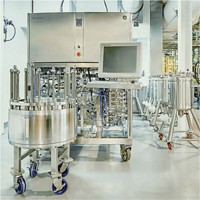Advertisement
Grab your lab coat. Let's get started
Welcome!
Welcome!
Create an account below to get 6 C&EN articles per month, receive newsletters and more - all free.
It seems this is your first time logging in online. Please enter the following information to continue.
As an ACS member you automatically get access to this site. All we need is few more details to create your reading experience.
Not you? Sign in with a different account.
Not you? Sign in with a different account.
ERROR 1
ERROR 1
ERROR 2
ERROR 2
ERROR 2
ERROR 2
ERROR 2
Password and Confirm password must match.
If you have an ACS member number, please enter it here so we can link this account to your membership. (optional)
ERROR 2
ACS values your privacy. By submitting your information, you are gaining access to C&EN and subscribing to our weekly newsletter. We use the information you provide to make your reading experience better, and we will never sell your data to third party members.
Business
Pause for Oligos
Fine chemicals companies look beyond the bad news on the therapeutic front
by MICHAEL MCCOY, C&EN NORTHEAST NEWS BUREAU
November 29, 2004
| A version of this story appeared in
Volume 82, Issue 48

The past several weeks have brought a little good and a lot of bad news for chemical companies that supply oligonucleotides to the pharmaceutical industry.
But the sobering reality is that only one such drug--Isis Pharmaceutical's Vitravene--has actually made it to the market. Moreover, two therapies in late-stage trials recently encountered major setbacks.
In October, the Food & Drug Administration told La Jolla Pharmaceutical that its lead drug candidate Riquent (abetimus), an oligonucleotide-based lupus treatment submitted to the agency in February, needed another multiyear study before it could be approved. Stock analysts said La Jolla will be hard-pressed to come up with the money required to complete the study.
Then earlier this month, Aventis ended a two-year-old agreement to commercialize Genasense (oblimersen), an oligonucleotide developed by Genta for fighting cancer. The original deal called for Genta to receive $135 million up front and hundreds of millions more in milestone payments. However, in May, FDA rejected the compound as a melanoma treatment, and Genasense recently showed mixed results as a leukemia treatment.
Producers of fine chemicals are doing their best to swallow the not-so-happy news. "Most people would share some level of frustration that these compounds haven't been as successful as hoped," says Mark Sullivan, business director for nucleic acids at Dowpharma. Oligo manufacturing, he says, is entering a "watchful waiting period" in which patience and financial stamina are virtues.
Oligonucleotides are small, DNA-like molecules that typically work by binding to RNA, proteins, or other targeted agents, rendering them inactive. Vitravene is called an antisense drug--because it goes against the sense, or code, of RNA--but the oligo category also includes small interfering RNA (siRNA), RNA interference (RNAi), and aptamer-based drugs. While Vitravene is a first-generation antisense drug, Acuity's Cand5 is an siRNA therapeutic.
Oligo-based drugs are being developed for a wide variety of indications. Vitravene was approved in 1998 for the treatment of cytomegalovirus-induced retinitis, an eye disease. Isis' pipeline holds 11 other oligonucleotides targeted at diseases ranging from arthritis to cancer to diabetes.
AS THEIR NAMES imply, Eyetech Pharmaceuticals and Acuity are also pursuing treatments for eye-related diseases. Replicor, in contrast, touts its REP 9 as having activity against viruses such as HIV, hepatitis B, herpes, and Ebola. Lorus Therapeutics, another Canadian firm, is aiming its GTI-2040 at lung, breast, and other cancers.
Inga Gwose, project manager for oligonucleotides at Girindus, says it was the depth and breadth of this pipeline that prompted her company to start exploring oligo contract manufacturing in 2000. In Kuensebeck, Germany, Girindus is developing a novel solution-phase production process that Gwose says offers the potential for low-cost manufacturing of what is now an expensive pharmaceutical.
In Cincinnati, meanwhile, the company is developing the more conventional solid-phase process. It brought in small-scale production equipment in 2002 and is just now completing installation of a larger scale machine, called OligoPilot 400, that it purchased from Amersham.
At Dowpharma, Sullivan notes that his company has had small-scale oligonucleotide manufacturing capability for a number of years. It stepped up its commitment in October 2003 with the opening of a plant in Midland, Mich., that can make up to 500 kg of oligos annually, one of the largest announced capacity figures in the industry.
While Dow, Girindus, and Lonza--which revealed its entry into the business early last year--are relative newcomers, Avecia and Degussa are considered the pioneers in providing bulk oligonucleotides to drug companies.
Avecia operates oligo plants in Milford, Mass., and Grangemouth, Scotland. In addition to Acuity, Avecia is the contract manufacturer for Genta's Genasense and for Corgentech, a South San Francisco biotech firm developing the oligonucleotide edifoligide, also known as E2F Decoy, for the treatment of bypass vein graft failure.
Degussa's Raylo Chemicals unit, meanwhile, has production in Edmonton, Alberta. It was hired last year by Eyetech to supply the active ingredient in Macugen, now in Phase II/III clinical trials. Raylo is also supplying Lorus with the oligonucleotide in GTI-2040, which is in Phase II trials.
In addition to competition with each other, chemical makers must contend with the specter of production by the drug companies themselves. Isis, for example, makes its own products at a new facility in Carlsbad, Calif., and also provides oligo manufacturing for outside customers such as Amgen, Lilly, Novartis, and OncoGenex. La Jolla Pharmaceutical handles its own production at its San Diego headquarters.
Eyetech made a move toward in-house manufacturing two weeks ago, announcing that it had spent $3 million to buy an oligonucleotide plant in Boulder, Colo., from Transgenomic Inc., a supplier of genomics research tools.
Karin Hehenberger, Eyetech's senior director for scientific and external affairs, notes that Raylo's Edmonton site will continue to be her firm's primary source of oligo supply while it brings the Boulder plant up to standards and that Raylo will be a key source thereafter as well.
HOWEVER, based on Eyetech's predictions about the timing and success of Macugen's commercial launch, Raylo's existing capabilities are only enough to meet demand for 18 to 24 months, Hehenberger says. Whereas Eyetech had earlier expected to meet its future needs by installing additional production lines at Raylo, now the Boulder plant "is our solution," she says. Fine chemicals industry executives understand drug companies' desire for in-house manufacturing capability. They see enough business to go around--provided that the oligonucleotide drug pipeline bears more fruit. And for that, they are looking to next-generation therapeutics.
Vitravene is considered a first-generation antisense oligonucleotide. It is composed of 21 DNA-like nucleotides that are protected by phosphorothioates to help prevent enzymatic degradation in the body. Isis' second-generation drugs incorporate 29-methoxyethyl chemistry on top of the phosphorothioate protection. In addition, they are composed of both RNA-like and DNA-like nucleotides, a combination that, according to Isis, creates greater affinity for RNA targets and, in turn, greater potency.
Beyond such second-generation antisense products are siRNA and RNAi therapies, which take the RNA silencing technique a step further. Such drugs are typically in a much earlier phase of development. Acuity, for example, says its manufacturing deal with Avecia is the first ever for a pharmaceutical siRNA product.
Many of the dozens of oligos in early clinical trials are next-generation products that reflect the drug industry's improving understanding of the RNA-blocking approach. Fine chemicals companies are now waiting for the trials to be successful and the orders to come in. As Dow's Sullivan says, "We have invested heavily in this space because we believe in it."






Join the conversation
Contact the reporter
Submit a Letter to the Editor for publication
Engage with us on Twitter